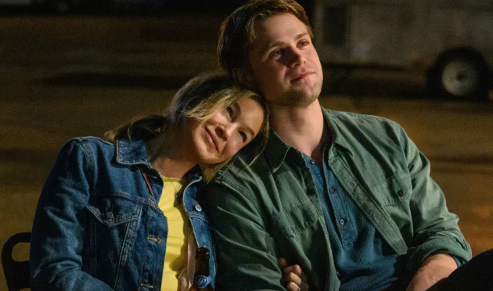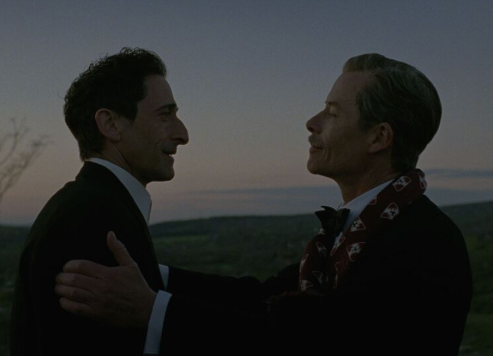Bridget Jones: Mad About The Boy

Cast: Renée Zellweger, Hugh Grant, Emma Thompson, Chiwetel Ejiofor, Colin Firth, Leo Woodall, Isla Fisher, Josette Simon
Director: Michael Morris
125 mins.
Not all romantic comedies have stood the test of time quite as well as 2001’s Bridget Jones' Diary. Director Sharon Maguire and her close friend Helen Fielding, who wrote the 1996 romance novel it was based on, crafted one of the true greats of its genre: witty, charming, and, in many ways, before its time. Bridget Jones’s Diary is so specific and tuned into British culture, and yet has simultaneously proved to be a universal story that continues to transcend generations. Most young women can relate to the film in one way or another, a strong trait carried throughout the best rom-coms. Alas, the franchise’s latest and final instalment, Bridget Jones: Mad About the Boy struggles to capture the untamed spirit that has come to be expected from its titular character and her narrative. The better part of a decade has passed, both in reality and in the plot, when we catch up with Bridget (Renée Zellweger) for one last time. Her solitary flat has been traded in for a terraced house, one that’s embellished with crookedly hung finger-paintings and scattered toys that stretch as far as the eye can see. Bridget’s youngest child, Mabel (Mila Janković), embodies all of her mother’s cheekiness. Meanwhile, her young son, Billy (Casper Knopf), carries himself much like his father, Mark Darcy (Colin Firth), whom Bridget wed in the final scene of the previous film, 2016's Bridget Jones' Baby. Everything Bridget had wished for over the years has finally come to fruition. However, as it can often be, life is unfair and unforgiving, as it’s revealed early on that her beloved husband Mark has died, leaving her to come to terms with not only suddenly becoming a widow, but also a single mother. Despite feeling certain that her dating days are over, Bridget, once again, finds herself at obscenely crowded dinner tables, receiving unsolicited advice from her friends on how to move forward with her life.
Endearingly, it is Daniel Cleaver (Hugh Grant), perhaps Bridget’s most infamous ex, that she can lean on for support, to the extent of being known to her kids as Uncle Daniel. After failing to appear in the franchise’s third instalment, it’s great to see Grant reprise one of his many rascally caddish roles. The unlikely friendship shared between the pair is one of the few aspects of Bridget Jones: Mad About the Boy that feels most authentic to the tone of the previous films, however, this nourishing dynamic is frustratingly absent for most of the running time, which contributes to the film’s biggest downfall: it rarely feels like you’re watching a Bridget Jones film. Though life can seem drab at times throughout the previous trio of outings, those emotions were consistently offset by a certain level of entertaining absurdity. But in Bridget Jones: Mad About the Boy, the franchise’s signature humour often seems totally rejected and has little other than recycled jokes and callbacks to offer in exchange. As the Bridget Jones character is synonymous with the early 2000s, it has become more obvious that it's the influence of previous co-writer Richard Curtis, who is known for scripting and directing some of the best romantic comedies of that time period, that is sorely missed. It’s no secret that Renée Zellweger is a gifted comedic performer, but the script at hand gives the Oscar-winner barely anything new to try out or a chance to revive the more brazen side of Bridget. Though her life persists, you get the sense that Bridget is consistently flatter than ever and lacks growth throughout the narrative. On the other hand, Hugh Grant is unsurprisingly still a real crowd-pleaser and seamlessly slips back into his hilarious performance as Daniel. Out of Bridget’s two new romantic interests, it is Chiwetel Ejiofor as Mr. Wallacker, a science teacher at Billy and Mabel’s school, who reigns supreme as a result of his natural and effortlessly charming performance. There is nothing wrong about Mr. Wallacker’s competition, Roxster, played by Leo Woodall, who is admirable enough in the role, but the romance between Roxster and Bridget, who is 26 years his senior, lacks that integral persuasive chemistry, especially in comparison to other recent films that explore age-gap dynamics. While Bridget Jones: Mad About the Boy is being called the last chapter in the franchise, it is the first to be directed by a man, Michael Morris and as such, the absence of a feminine touch is tangible. Bridget Jones: Mad About the Boy attempts to explore the notion of learning self-love as a middle-aged woman but lacks authenticity, due to its surface-level endeavours. All of this isn’t to say the film lacks emotionally provoking moments in all respects, as it does manage to portray just how unpredictable life can be in an earnest way. Yet, those tear-inducing moments are few and far between and, at times, even clichéd. As a result, we’re left with a story that lacks what made the other Bridget Jones sequels so engaging and feels like a major stumble at the finishing line.

Cast: Adrien Brody, Felicity Jones, Guy Pearce, Joe Alwyn, Raffey Cassidy, Stacy Martin, Emma Laird, Isaach de Bankolé
Director: Brady Corbet
215 min.
Writer/Producer/Director Brady Corbet centres The Brutalist around a battle of wills between the pursuit of personal artistic expression and the diabolical capitalism that constrains it. Set in post–World War 2 America, the film follows the decade-long creative and moral pursuit of László Toth, a Hungarian Jewish Holocaust survivor newly re-settled in Pennsylvania. But The Brutalist is also a film about its own construction, calling attention to its precision and scope by making architecture its literal theme and more of a guiding narrative principle than a visual element. We don’t see much brutalist architecture in The Brutalist, just the teasing promise of grandiosity. Toth is played by Adrien Brody with a circumspect, reticent intelligence that refuses to tip over into mere victim. In the effective, conceptually powerful opening sequence, Corbet drops us without context into darkness, as Toth and his fellow boat passengers slowly emerge from a dank claustrophobic void, the camera crammed in among the teeming crowd, the viewer disoriented enough to wonder whether the confused, frightened voices we hear are being summoned to their deaths.
Toth has arrived in New York after his long journey as a hollow husk. After a sombre welcome to lower Manhattan, including a grimly explicit engagement with a sex worker, this ragged soul, of whom we know little other than a diffident, untrusting facial expression, will re-locate to the milder suburbs of Doylestown. Here, he reconnects with cousin Attila (Alessandro Nivola), a fully assimilated, Catholic-converted furniture store owner who betrays only the wisp of an Eastern European accent. Toth’s stay with Attila and his wife, Audrey (Emma Laird), fraught with the newly upwardly mobile couple’s paranoia and latent wish to leave behind their Jewish past, ends quickly and poorly, yet his brief employment with Attila leads him into the fateful orbit of Harrison Lee Van Buren. Well played by Guy Pearce with the kind of titanic gusto that remains agreeably on the razor’s edge of camp, the local industrialist becomes both antagonist and benefactor to Toth, whom he takes an extreme and suspicious liking to, especially after discovering his Bauhaus education. Toth is engaged by Van Buren to bring his architectural genius to a mammoth vanity project, a recreational centre perched at the top of a hill that will allegedly serve the local Doylestown community but which would more sturdily provide lasting testament to Van Buren’s own wealth and performative generosity. Perhaps most importantly to Toth, Van Buren takes an apparently sincere interest in helping to get his wife, Erzsébet (Felicity Jones), out of Hungary, giving the architect even more incentive to indulge both Van Buren’s whims and his own vision. The planning and fabrication of the Van Buren community centre provides the foundation for The Brutalist, as it constructs its narrative brick by brick. Corbet’s three-and-a-half-hour film, co-written with his wife, Norwegian filmmaker and actress Mona Fastvold, initially seems to predict an expected rise-and-fall chronicle, unfolding across two large chapters, and moving from stately to frenetic near-collapse. Shot on 35mm in shades of ominous grey by cinematographer Lol Crawley in the mid-century VistaVision format, and there’s also more than a hint of 21st-century Paul Thomas Anderson here, especially in the mix of grandiosity and willful eccentricity that defined There Will Be Blood and The Master. But whereas those films replaced the traditional masculinist angst of seventies Hollywood offerings with an anxiety that set history off its hinges, Corbet’s film, with its surprising music cues and percussive visual flourishes, matches them to the narrative of a man who’s less anti-hero than underdog.
The curious tonal shifts of The Brutalist are never clearer than in its second half, when the film goes obstinately bonkers, leaving behind the first movement’s trudging, cause-and-effect realism for a heightened, not entirely persuasive symbolism. Among the forbidding quarries of Carrara in central Italy, where Toth has taken Van Buren to scout the world’s finest marble, a shocking, left-field act of violence reconfigures the film into the realm of metaphor. This is a film of moral ambiguity shifts, and Corbet leaves all his cards on the table. Whatever its many limitations, The Brutalist reaches its lumberingly operatic—and murkily confusing—climax, and the full flowering—and meaning—of his building’s design, form, and structure is not revealed until a brief epilogue set at a museum gala celebrating Toth many decades later, shot with a blurry video-like texture that both craftily obscures some iffy ageing make-up and nicely situates the viewer in a mindset of modern retrospection. In these closing moments, with Toth’s building on the hill in Pennsylvania a trojan horse for smuggling in and re-purposing his post-war trauma, it’s an esoteric epitaph to Jewish genocide. The Brutalist is about grand gestures and moral reckoning - which is appropriate for a film about architecture that, despite its scale, tends to tell rather than show, with the most lasting image being one we do not fully see until a final crucial moment. As part of his vision for Van Buren’s commissioned building, Toth has cut out a cross in the roof, which at certain times of day the sun will shine through, casting a ray of light in its cruciform shape on the atrium’s floor. Pitched to the community while the project is in its planning stages, the idea is clearly meant to flatter the God-fearing Protestant locals. The promise of the cross and the daylight it casts—not of truth but of accusation—is the film’s ultimate emblem of simultaneous assimilation and resistance, slicing down the centre of this curious, frustrating, formidable monolith of a film.